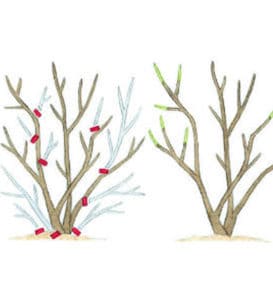This article is courtesy of Sunset Magazine.
There are four basic pruning cuts, each aimed at producing a different effect.
For cuts that involve cutting above a growth bud, angle it at about 45 degrees, with the lowest point of the cut opposite the bud and even with it, the highest point about 1/4 inch above the bud.
1. Pinching
One of the easiest “cuts” to make can be achieved without cutting: you simply pinch off a terminal bud with your thumb and forefinger. Pinching stops the stem from elongating and encourages bushy growth. It is typically done on annual and perennial flowers and on some vegetables; it’s also effective for directing growth on small-leafed shrubs to give the plant an even shape.
At right are three types of pruning cuts: pinching removes the terminal growth; heading removes part of the shoot; and thinning eliminates the entire shoot.
2. Heading
For heading, you cut farther back on the shoot than you would for pinching. In most cases, the lateral bud has already grown a leaf, and you make the cut right above the leaf. Usually done with hand-held pruners, heading stimulates the buds just below the cut, encouraging dense growth. Heading is a more aggressive approach than pinching when you’re shaping certain small shrubs and flowering perennials.
3. Thinning
Thinning reduces the bulk of a plant with minimal regrowth: each cut removes an entire stem or branch, either back to its point of origin on the main stem or to the point where it joins another branch. Because you remove a number of lateral buds along with the stem or branch, you’re less likely to wind up with clusters of unwanted shoots than you are when you make heading cuts. (A common mistake of inexperienced gardeners is to make a heading cut when what’s needed is a thinning cut.) Use hand-held pruners, loppers, or a pruning saw to make thinning cuts, depending on the thickness of the member being cut.
4. Shearing
Shearing, customarily used to create a hedge or a bush with spherical or square form, is a form of heading that makes no attempt to cut back to a bud. However, because plants chosen for this treatment typically have many lateral buds close together, you’ll usually end up cutting near a bud. Shearing stimulates many buds to produce new growth, so you’ll be repeating the job regularly once you start. Since this method cuts right through leaves, it’s best done on small-leafed plants, where damage is less noticeable. Use hand-held or electric hedge shears for this kind of pruning.
